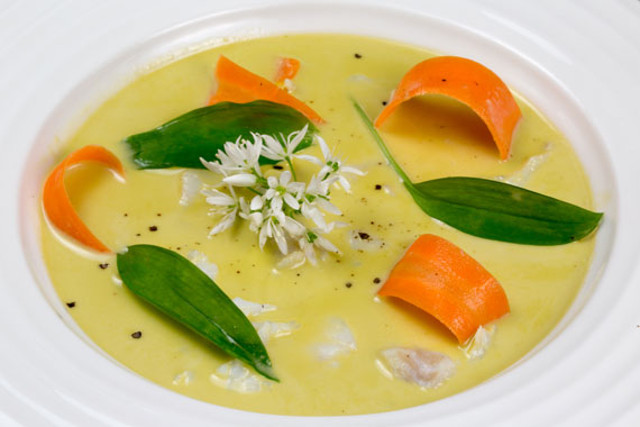Fisk soppa med ramslök och morötter (fish soup with wild garlic and carrots) is a filling soup and so it makes a tasty and attractive main course for lunch.
The recipe is based on one I came across in Mannerströms Fisk, a book by Leif Mannerström, probably Sweden’s best known chef and surely one of Sweden’s oldest working chefs (he was born in 1940). He has run several restaurants, written many books and is currently a regular television judge on Sveriges mästerkock (Sweden’s Master Chef) and Sveriges yngsta mästerkock (Sweden’s Young Master Chef). Both programmes can be seen online on Sweden’s TV4 channel.
Summary
Serves: 4
Level: Easy
Preparation: 10 minutes
Cooking: 25 minutes
TOTAL: 35 minutes
Tips
• Leif recommends using stenbitsfilé (cat fish fillets), which can be bought online, at least in the UK. (As my fishmonger never stocks catfish I normally ask for a bag of mixed white fish, such as cod, pollack or haddock, instead.)
• Wild garlic (also known as ramsons) can be picked from March until June, depending on where you live. If wild garlic is out of season, use chives instead.
The bunch above weighed 90 grams.
• Pick a medium sized bunch as shown, avoiding any very large leaves as they tend to be bitter.
• If you plan to freeze the soup do so before adding the fish. (I freeze it in 300 ml whipping cream tubs.) To serve, defrost the soup, gently reheat and serve with freshly cooked fish. Garnish with chives if wild garlic is no longer in season.
• The soup is superb with some good white sourdough. For our recipe click here.
Ingredients
| 4 | small carrots | |
| 600 g | (1¼ lb) | skinless white fish pieces |
| 2 tbsp | oil | |
| 1 | onion, finely diced | |
| 100 g | (4 oz) | celeriac, peeled and diced |
| 150 g | (6 oz) | floury potato, peeled and diced |
| 600 ml | (2½ cups) | fish stock |
| 1 tbsp | white wine vinegar | |
| 2 | fresh bay leaves | |
| 300 ml | (1¼ cups) | whipping cream |
| 90 g | (1 bunch) | wild garlic leaves |
| salt and pepper |
Method
1. Peel the carrots and slice thinly with a potato peeler. Put them in a bowl of cold water and leave them to soak.
2. Cut the fish into 1 cm x 1 cm (½” x ½”) pieces and set aside.
3. Heat the oil in a large saucepan and fry the diced onion, celeriac and potato for about 5 minutes, until softened but not browned.
4. Add the fish stock, vinegar and bay leaves and simmer for 10-15 minutes until the vegetables are soft.
5. Add the cream and bring the mixture back to a gentle simmer.
6. Add the wild garlic, but reserve a few small leaves to use as a garnish. Simmer for a minute or so until wilted and then liquidise the mixture.
7. Sieve the mixture into saucepan. Season to taste with salt, pepper and possibly a little more vinegar. Keep warm.
8. Boil up a saucepan of lightly salted water. Add the fish and leave it to simmer for 2-3 minutes.
9. Divide the fish between 4 deep soup bowls and add the reserved carrot slices.
10. Whisk the soup so it is nice and foamy and pour over the fish. Garnish with the reserved wild garlic leaves.
Recipe courtesy of John Duxbury, founder and editor of Swedish Food.



 Please whitelist us to continue reading.
Please whitelist us to continue reading.